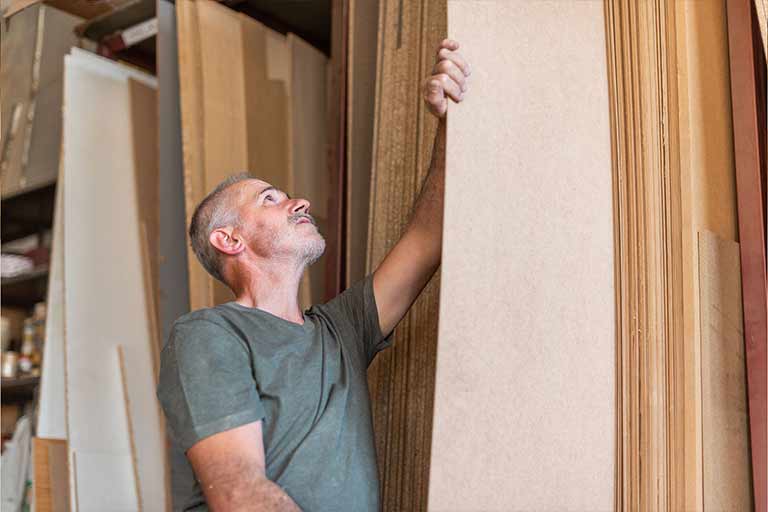
Plywood Specifications
Plywood Specifications
Famous for their strength and durable construction, plywood has a long journey. It is to make logs of trees such as birch, beech, poplar, and then to select and peel the smooth ones from these trees and turn them into panels in certain sizes in layers. Thin sheets are peeled from wood logs by rotating them along their horizontal axis. The veneer sheets from this process are cut to size, dried, glued together and then pressed at 140°C (284°F) and 1.9 MPa (280 psi). Thus, the plywood panel is created. Plywood specifications and advantages are more than every sector and expectation.
The cross grains of plywood improve dimensional stability by reducing expansion and contraction. This specification ensures that the panels are solid in both directions. An odd number of leaves also reduces warping. Another specification of plywood is that too cold or heat does not affect its properties such as size or durability. The diagonal splitting of plywood as a structure slightly reduces its tendency to split when nailed on the edges. Plywood holds nails. It doesn’t disintegrate. Plywood adds more durability to parts that need to be stronger.
Advantages of Plywood
- It is light.
Plywood is lightweight. Thanks to its light structure, it is more preferred especially in home and garden furniture. In addition to its robust structure, its lightweight structure highlights its suitability for use. Its light structure also provides convenience during the production and assembly of the product.
- It is a durable material because the wood fibers forming the layers combine in different directions (90 degrees to each other). Not easily broken.
They are especially preferred as shelves, as they are materials that do not break easily due to their structure. With its durable structure, it is more robust against the load on it.
- It can be produced in desired dimensions in thicknesses of 6-30 mm.
Plywoods can be produced in any size according to the product to be produced. Thanks to these features, they can be preferred in more sectors and areas. Thin flexible plywood is the most preferred reason for decorative purposes, especially in interior architecture.
- It is widely used in many industries.
The main reasons why plywood is preferred in many sectors are; besides their solid structure, they are decorative, light and produced according to the requested thickness.
- It is resistant to cracking.
Compared to other wood materials, there is no wear such as cracking. Especially quality products such as birch are resistant to water and wear due to the forest they come from. This is the main reason why it is preferred especially in terms of exterior architecture.
- It has high screw holding feature.
Plywood grades generally hold materials like nails strong. It does not cause cracking or abrasion, especially in processes such as screwing during assembly. Materials such as screws have high holding properties.
- It is environmentally friendly.
Since it is produced from natural materials, it is easy to disappear in nature. And at the same time, it has a durable structure for long-lasting use.
- It is economical.
Although it seems expensive compared to other materials in terms of price, it is used in the production of products that can be used for many years thanks to its long-lasting and robust structure. Since it does not show features such as wear and tear, it serves for many years and this actually makes it economical.
- The plywood surface can be polished. It can be painted.
With this feature, it has a smooth structure. It does not hold dust and bacteria, it is easy to clean. Smooth exterior plywood reduces the cleaning to the easiest level.
- It has high resistance to water.
It is the biggest reason why it is preferred for outdoor architecture. Thanks to its cold or water resistant structure, it provides long-term use even in winter environments.
- Compared to solid wood, it is stronger than boards of the same thickness.
- There is no possibility of shrinkage and swelling.
- More wood and less chemicals are used in its production. It has a natural wood appearance, has high mechanical properties, and has a high nail and screw holding ability. As an average minimum of harmful emissions and particles are emitted, it is not harmful to human health as an industrial product.
Plywood is easy to clean. Cleanliness and hygiene are among the issues that we all pay attention to. As you know, germs and viruses stick to furniture and stay there for a long time. Since the beginning of 2020, a virus called corona virus (COVID-19) has been posing a great danger to the world. The biggest enemy of this virus, which infects the places we touch and spreads very quickly, is cleanliness. Thanks to its smooth surface and durable structure, it can be easily cleaned with many cleaning materials.
Disadvantages of Plywood
- Since the tree layers are joined on top of each other with glue and press, the layers are visible from the edges. Therefore, the edges must be coated separately in the furniture industry.
- Although Mdf is durable compared to chipboard, it is a more expensive material.
- It is a difficult material to cut. During cutting, breakage may occur on the edges.
As a highly advantageous raw material, plywood is the most preferred material for production by many industries. Being environmentally friendly, resistant to water and cold weather, or being in the product group that is least affected by environmental factors, Both exterior plywood and interior plywood has become indispensable production materials